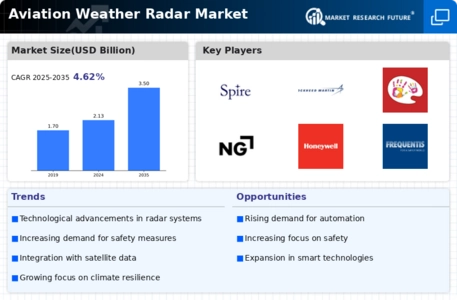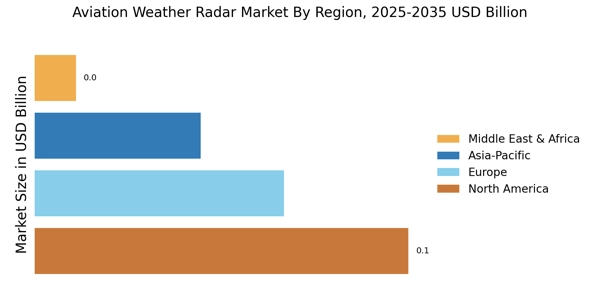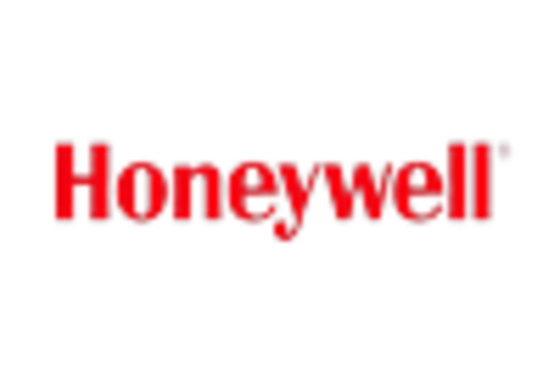Increased Safety Regulations
The aviation weather radar Market is significantly influenced by the rise in safety regulations imposed by aviation authorities. Regulatory bodies are mandating the installation of advanced weather radar systems in commercial and cargo aircraft to ensure passenger safety and operational reliability. These regulations are often a response to past incidents where inadequate weather information contributed to accidents. As a result, airlines and operators are compelled to invest in modern radar technologies to comply with these regulations. The market is expected to witness a steady increase in demand for aviation weather radar systems, with projections indicating a potential market size reaching several billion dollars by the end of the decade. This trend underscores the critical role of regulatory frameworks in shaping the aviation weather radar landscape.
Technological Advancements in Radar Systems
The Aviation Weather Radar Market is experiencing a surge in technological advancements, particularly in radar systems. Innovations such as phased array radar technology enhance the accuracy and reliability of weather detection. These advancements allow for real-time data processing, which is crucial for flight safety and operational efficiency. The integration of artificial intelligence and machine learning algorithms into radar systems further improves predictive capabilities, enabling better decision-making for pilots and air traffic controllers. As a result, the market is projected to grow significantly, with estimates suggesting a compound annual growth rate of over 5% in the coming years. This growth is driven by the increasing demand for advanced weather radar systems that can provide precise information about severe weather conditions, thereby enhancing safety in aviation operations.
Growing Demand for Accurate Weather Forecasting
The Aviation Weather Radar Market is driven by the growing demand for accurate weather forecasting in the aviation sector. Airlines and operators require precise weather data to optimize flight routes, reduce fuel consumption, and enhance passenger comfort. The increasing frequency of extreme weather events necessitates the use of advanced radar systems that can provide timely and accurate information. As a result, investments in aviation weather radar technologies are on the rise, with market analysts estimating a potential growth rate of around 6% annually. This demand is further fueled by the need for improved situational awareness among pilots and air traffic controllers, ensuring safer and more efficient air travel. The emphasis on accurate weather forecasting is likely to continue shaping the aviation weather radar market in the foreseeable future.
Integration of Weather Radar with Other Systems
The Aviation Weather Radar Market is witnessing a trend towards the integration of weather radar systems with other aviation technologies. This integration allows for a more comprehensive approach to weather monitoring and management. By combining radar data with satellite imagery and other meteorological information, aviation stakeholders can achieve a holistic view of weather conditions. This synergy enhances decision-making processes for pilots and air traffic controllers, leading to improved safety and operational efficiency. The market is likely to benefit from this trend, with analysts predicting a growth trajectory that could see the aviation weather radar market reach new heights. The integration of systems not only streamlines operations but also fosters collaboration among various aviation entities, further solidifying the importance of advanced weather radar technologies.
Expansion of Air Travel and Airport Infrastructure
The Aviation Weather Radar Market is poised for growth due to the expansion of air travel and airport infrastructure. As more airports are developed and existing ones are upgraded, the need for advanced weather radar systems becomes increasingly critical. New airports are often equipped with state-of-the-art radar technologies to ensure safe operations in varying weather conditions. Additionally, the rise in air travel demand, particularly in emerging markets, is driving investments in aviation weather radar systems. Market forecasts suggest that the aviation weather radar sector could see a substantial increase in revenue, potentially exceeding several billion dollars as new infrastructure projects are initiated. This expansion not only enhances safety but also improves the overall efficiency of air traffic management.

















